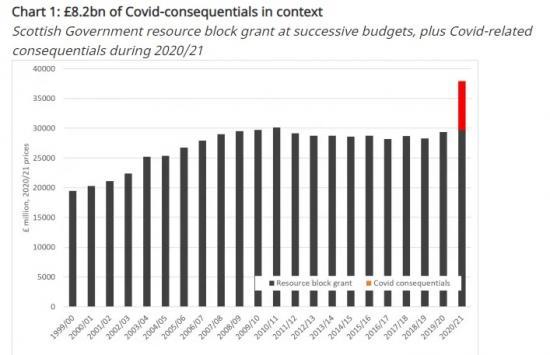The Evolution Of The Scottish Budget 2020/21 - And A Look Forward To The Spending Review
25th November 2020

This article is published on the Fraser Allender Institute web site. To read the full article go to the link at the bottom of the page.
Introduction
That 2020 has been a year without precedent scarcely needs saying. The unprecedented nature of 2020 is no more obvious than when it comes to the public finances - and the Scottish Government's budget is no exception.
The Scottish Budget will receive over £8bn in additional spending consequentials in 2020/21 than was anticipated when the budget was agreed in February.
In the context of a block grant at the start of the year of £30bn, that is clearly a substantial increase. It represents almost £1,500 of additional spending per capita.
The pace at which new funding has been allocated and new policies have been announced means that keeping track of how the additional funding has been allocated in Scotland is not always easy. Over £2bn of consequentials remain to be formally allocated (although significantly less than this remains uncommitted).
What we do know is that over £2.4bn additional funding has been allocated to health. Business support comes in the form of over £1.5bn worth of grant support, in addition to £900m of business rates reliefs. Transport operators have received over £350m of support. A plethora of policies have been targeted at households most at need of financial support, with funding totalling over £400m. And new funding has been made available to support further and higher education and develop new training and employability initiatives.
The Scottish Government will soon begin turning its thoughts to its budget for 2021/22 - Finance Minister Kate Forbes is due to present her tax and spending plans to parliament on 28th January.
The UK Government's spending plans for 2021/22 - which will be laid out by Rishi Sunak on Wednesday - provide critical context for that planning. The plans laid out by the Chancellor will determine the size of the Scottish block grant, and the broad envelope that the Scottish Government will have to work with (even with significant tax devolution, the block grant remains critically important in determining the overall size of the spending envelope available to the Scottish Government).
Of critical importance here will be the extent to which Covid-related funding changes announced during 2020/21 – particularly around the NHS and business support measures – will be baked-in to departmental settlements, or will be unwound in the expectation of the beginnings of recovery.
To provide some context, this article summarises the ways in which the Scottish Budget has evolved since March 2020, and some of the fiscal issues that have emerged.
Over £8 billion of additional consequentials will flow to the Scottish Budget during 2020/21 to mitigate the effects of Covid
The Scottish Budget 2020/21, as approved by parliament in February, set out plans for resource spending of almost £35bn, underpinned by a core block grant from the UK Government of £30bn. At the time, Covid was not perceived as a significant economic risk.
By the time of the UK Budget on 11 March, Rishi Sunak opened his budget statement by saying that Covid was ‘the issue most on everyone's mind'. He outlined the UK Government’s initial measures to mitigate what he described as the virus’ ‘temporary’ but ‘significant’ impact on public health and the economy. These measures included additional funding for the NHS in England, and business rates relief for businesses in the retail and hospitality sectors in England.
These announcements, and others, generated additional consequentials for the Scottish Budget. Over the course of the next few weeks, additional UK Government announcements on a seemingly weekly basis added further to the consequential amounts.
By mid-April, £3.5 billion of additional resource consequentials had been allocated to the Scottish Budget as a result of UK Government Covid-related spending in England. This figure had increased to £4.6bn by the time of the UK Government’s Summer Economic Update on 8 July.
Up until this point, the UK Government had determined increases to the Scottish block grant by applying the Barnett Formula in the usual way. UK Government announcements of spending increases in England generated consequential increases in the Scottish block grant.
But the problem with relying on the Barnett Formula during a time of fast-moving crisis was that it resulted in lags between the UK Government announcing a policy for England, and the devolved governments being able to design and announce their own schemes – which they could only do once they had learnt of the consequentials arising from the UK Government policy.
In response to this, the Treasury moved to a system of guaranteed funding for the three devolved governments. On 24 July, the Scottish Government was notified that it would be guaranteed a minimum £6.5bn uplift in consequentials during 2020/21. This was an upfront guarantee of funding that provided £800m of additional resources over and above the uplift in the Scottish block grant that would have been identified at that point in time had Barnett been applied in the normal way.
In principle this meant that the Scottish Government did not need to wait for the UK Government to make policy announcements for England before it decided how and when to provide support in Scotland.
The guaranteed amount was increased to £7.2bn on 9 October and then to £8.2bn on 11 November[1].
The scale of this increase in block grant allocation is unprecedented (Chart 1). To put it in some context, the resource block grant at the time of the 20/21 budget was around £29.7bn. Whilst not all of the £8.2bn consequentials will translate into additional spending (as discussed below, around £900m will offset additional business rates reliefs), a spending increase of £7bn would equate to 23% higher spending than was anticipated at the time of the budget.
Read the full article HERE
